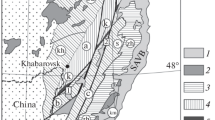Abstract
During six recent expeditions, of which four were led by the author, to the mainly basaltic island of Jan Mayen (length 53.6 km; mean width 7 km; area 380 km2), evidence has been gathered for at least six distinct volcanic phases, coupled with rythmic magmatic variations in the oceanite-trachybasalt-trachyandesite-trachyte lava suite. There are also certain intermediate types and associate pyroclasts, and effusive or explosive uprise of these lavas through two fissure-swarms, intersecting at about 12°, produced a subaerial volcano-group of several hundred cones, elongate north-east — south-west on the north-west margin of a large submarine pedestal possibly capped by a drowned plane of marine erosion at 100–200 m below present mean sea level. These rocks appear to range in age between Tertiary and Recent.
Jan Mayen grows from the north-west flank of the submarine Mohns Ridge close to its axial rift within a markedly seismic zone, at a likely junction of crustal fractures immediately north of a sharp east-west flexure in the rift which may indicate a major strike-slip fault. The lavas have affinities with corresponding lavas in Scottish Hebrides and with the basalt-trachyte associations on the islands of Ascension, St Helena, Tristan da Cunha and Gough on the mid-Atlantic Ridge.
Both form and structure suggest the island mass has the configuration of a volcanic dome (or possibly two coalescent domes diverging slightly south-west) at least 70×30 km in area and about 1.5 km in height.
In the mass are two distinct major volcanic foci: an earlier South Jan or Rudolftoppen « dispersed » or « plexiform » vent, ascribable to numerous «drilled out» fissure-intersections within an area of more than 25 km2, and a later North Jan or Beerenberg central vent. A third focus of indeterminate relative age may lie beneath Straumflaket, in the shallow sea off South Cape.
Magmas rose through individual fissures and their intersections, to form linear cones of tuff and lava, and extensive basalt floods. Most are vertical dikes but, in places, highly inclined sheets and sills tend to follow bedding and other planes of weakness in tuff and sometimes fed lava flows. Basaltic magma invaded a complex system of intersecting master fissures and subsidiary fractures in tuff near the surface, inflated the mass, distorted and generated local joint systems in the tuff and finally gave rise to meshworks of basaltic sheets in it.
Following a long period of repeated fissure eruption, ten of the main basaltic throats at the South Jan dispersed focus, and one near the junction between North Jan and South Jan, were plugged by trachyte, after which there was volcanic quiescence with contemporaneous deep glacial, fluvial and marine erosion. During the subsequent resumption of volcanic activity the North Jan focus of central eruption rose to importance at the expense of the South Jan focus, which remained sealed by trachyte, but numerous small basaltic fissure volcanoes erupted on the seaward edges of the South Jan plateau and through the coastal platform beneath its cliffs, at or near sea level.
Similar content being viewed by others
Author information
Authors and Affiliations
Additional information
Paper read at the IAV International Symposium on Volcanology (New Zealand), scientific session of Nov. 23, 1965.
Rights and permissions
About this article
Cite this article
Dollar, A.T.J. Genetic aspects of the Jan Mayen fissure volcano group on the mid-oceanic submarine Mohns Ridge, Norwegian Sea. Bull Volcanol 29, 25–26 (1966). https://doi.org/10.1007/BF02597137
Issue Date:
DOI: https://doi.org/10.1007/BF02597137




